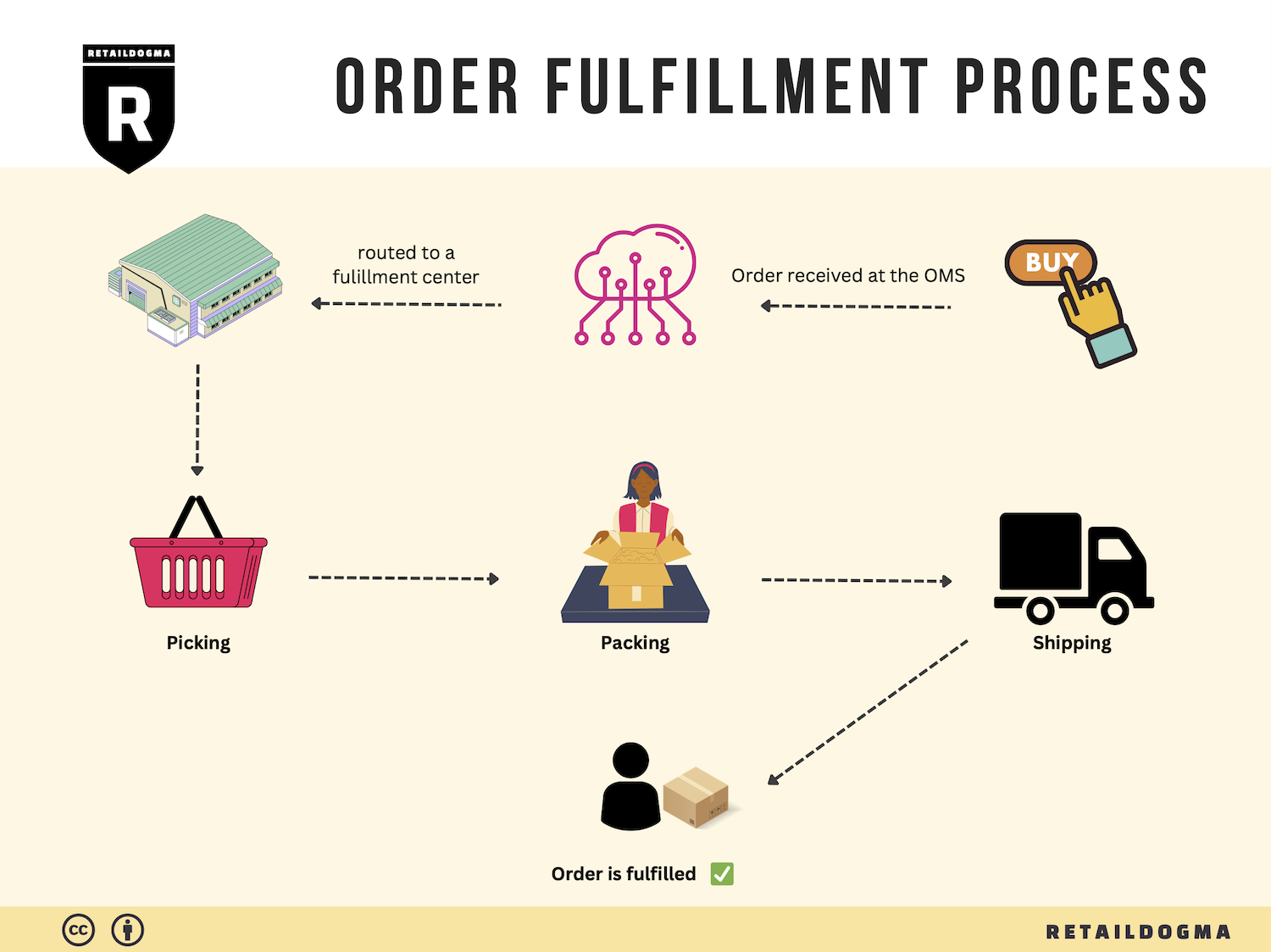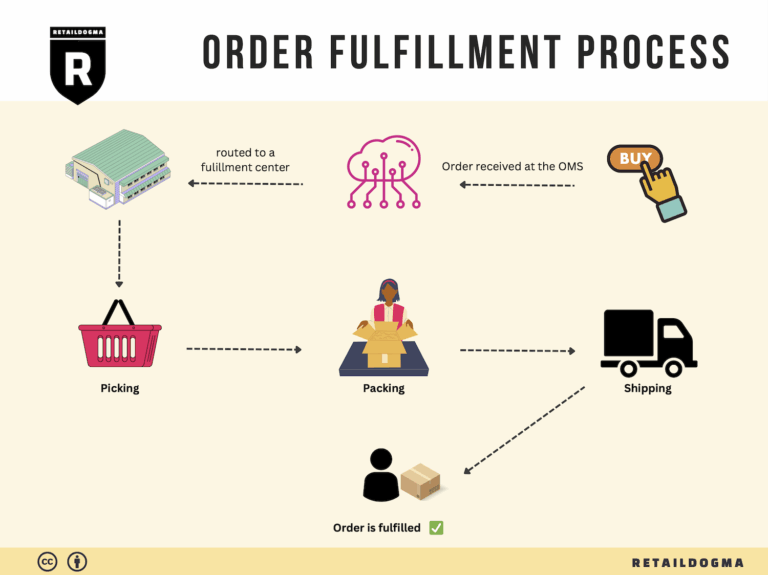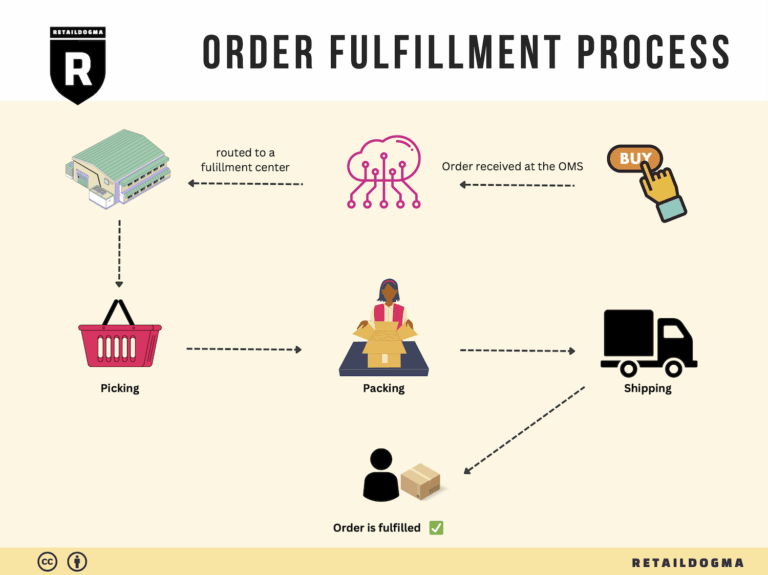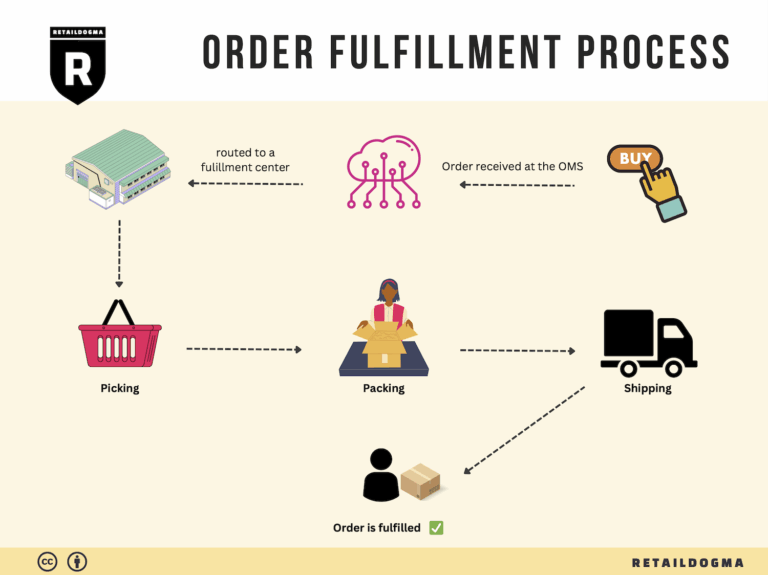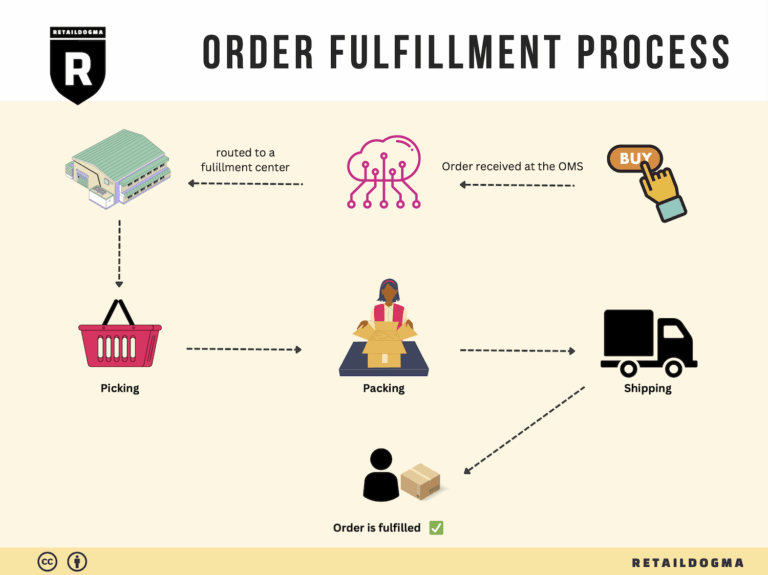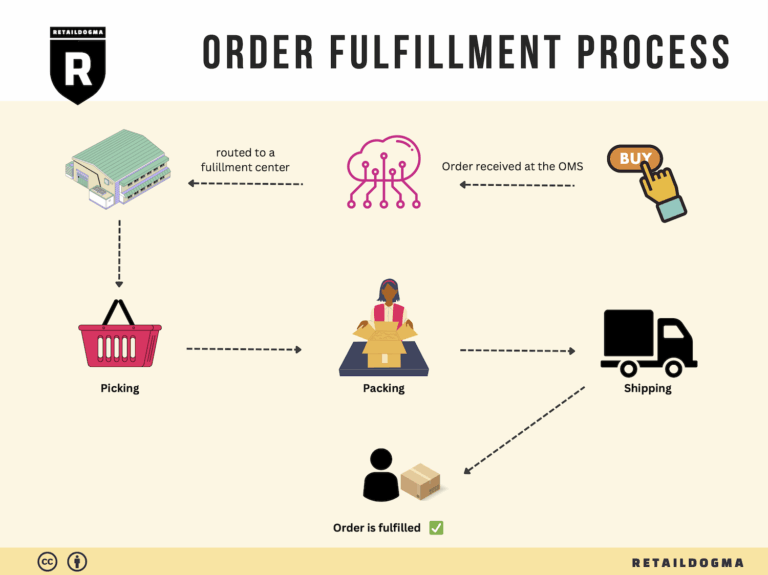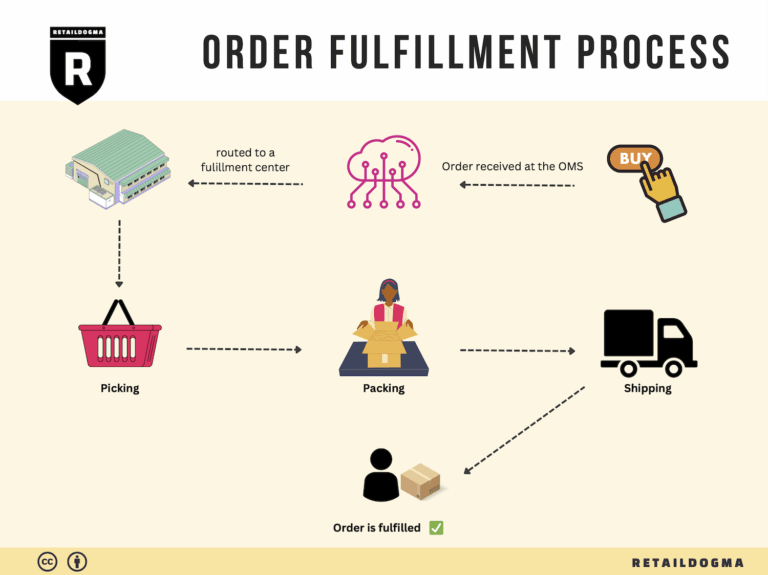What Is A Fulfillment Center? A Complete Guide (2025)
What is E-commerce Fulfillment? An Introduction for Growing Businesses
Understanding E-commerce Fulfillment: A Critical Component for Growth
As an e-commerce business owner, you may find yourself drowning in the logistics of packing and shipping orders. The excitement of scaling your business can quickly turn into overwhelm when faced with the complexities of order fulfillment. After all, fulfillment is not just about getting a product to a customer; it’s about delivering a seamless experience that can foster loyalty and drive repeat sales.
In its simplest form, e-commerce fulfillment refers to the entire process of receiving, processing, and delivering an order to the customer. This includes everything from inventory management and order processing to packing and shipping. As your business grows, navigating these processes efficiently becomes crucial to maintaining customer satisfaction and operational efficiency.
This guide aims to demystify e-commerce fulfillment for growing businesses. We will explore various fulfillment models, including third-party logistics (3PL) and Fulfillment by Amazon (FBA), helping you understand the advantages and challenges associated with each. You’ll gain insight into core services offered by fulfillment partners, such as inventory management, order tracking, and returns processing, which are essential for a smooth operation.
Choosing the right fulfillment partner can be a daunting task. We’ll provide you with a roadmap to assess potential partners, focusing on factors such as technology integration, scalability, and customer service. Understanding pricing structures is equally important; we’ll break down the cost elements involved in outsourcing fulfillment, enabling you to make informed financial decisions.
Ultimately, the goal of this guide is to empower you with the knowledge and tools needed to make smart decisions about your logistics strategy. By understanding the intricacies of e-commerce fulfillment, you can streamline your operations, enhance customer experiences, and focus on what you do best: growing your business. Whether you are just starting or looking to refine your current processes, this guide will serve as a valuable resource in your e-commerce journey.
What You’ll Learn In This Guide
- What is E-commerce Fulfillment? An Introduction for Growing Businesses
- The Order Fulfillment Process: From ‘Buy’ Button to Customer’s Door
- Comparing Fulfillment Models: In-House vs. 3PL vs. Dropshipping
- A Deep Dive into Amazon FBA: Pros, Cons, and Who It’s For
- Core Services Offered by Fulfillment Centers
- How to Choose a Fulfillment Partner: A 6-Point Checklist
- Understanding Fulfillment Pricing: A Breakdown of Common Fees
- Frequently Asked Questions (FAQs) about Fulfillment
- Conclusion: Is Outsourcing Fulfillment the Right Move for Your Business?
- Important Disclaimer
The Order Fulfillment Process: From ‘Buy’ Button to Customer’s Door
1. Receiving Inventory
The first step in the order fulfillment process begins with receiving inventory from suppliers. This involves checking shipments against purchase orders to ensure accuracy in quantities and product specifications. Key tasks include inspecting for damages, verifying product details such as SKUs (Stock Keeping Units), and logging the items into the warehouse management system (WMS).
Importance: Accurate receiving is crucial because it sets the foundation for inventory accuracy throughout the entire fulfillment process. Any discrepancies at this stage can lead to stockouts or overstock situations, ultimately affecting customer satisfaction and operational efficiency.
Key Term: SKU (Stock Keeping Unit) – A unique identifier for each product, which facilitates tracking and inventory management.
2. Warehouse Storage
Once inventory is received, it must be stored efficiently within the warehouse. This involves categorizing items based on various factors such as size, weight, and demand frequency, and placing them in designated locations. Advanced WMS technology can optimize storage locations based on real-time inventory levels and sales data, ensuring that fast-moving items are easily accessible.
Importance: Effective storage solutions not only maximize space utilization but also streamline the picking process. When items are stored logically, it reduces the time taken to locate products, thus enhancing overall operational efficiency.
Key Term: Location Codes – Designations used within the warehouse to identify where specific items are stored, facilitating quick retrieval during the picking process.
3. Order Picking
The order picking stage is where fulfillment truly begins. When a customer places an order, the warehouse staff retrieves the ordered items based on a pick list generated by the WMS. This list details the specific items, quantities, and their storage locations within the warehouse. Various picking methods, such as single order picking or batch picking, can be employed based on order volume and complexity.
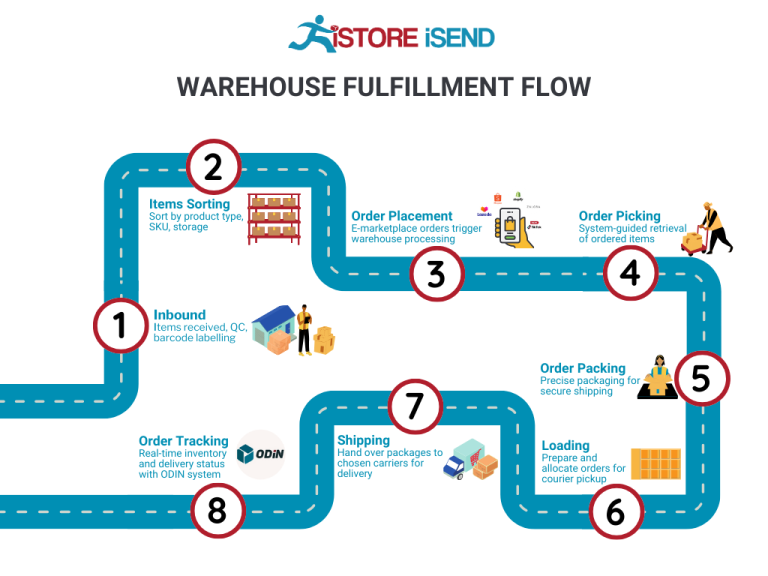
Importance: Efficient order picking directly impacts delivery times and customer satisfaction. The faster and more accurately items are picked, the quicker the fulfillment process can move to the next stage. Mistakes in this phase can lead to incorrect orders, which can harm the brand’s reputation.
Key Term: Pick List – A document or digital report that outlines the items to be retrieved for an order, including their locations in the warehouse.
4. Order Packing
After items are picked, they are brought to the packing station where they are prepared for shipment. This process includes checking the items for accuracy, selecting appropriate packaging materials, and assembling the order. Packing slips and labels are generated to accompany the shipment, providing necessary information for both the carrier and the customer.
Importance: Proper packing is essential to ensure that products arrive at the customer’s door in excellent condition. It also plays a significant role in branding; thoughtful packaging can enhance the customer experience and foster brand loyalty. Additionally, efficient packing helps reduce shipping costs by optimizing package size and weight.
Key Term: Packing Slip – A document included in the package that outlines the contents of the order, serving as a receipt for the customer and a reference for returns.
5. Shipping & Delivery
The final step in the fulfillment process is shipping the packed orders to customers. This involves selecting the appropriate shipping carrier based on factors such as cost, delivery speed, and service level. Once the packages are handed over to the carrier, tracking information is generated and communicated to the customer.
Importance: Timely and accurate shipping is crucial for customer satisfaction. The delivery experience can significantly influence a customer’s perception of a brand. Efficient shipping practices not only ensure that products arrive on time but also help to manage costs effectively.
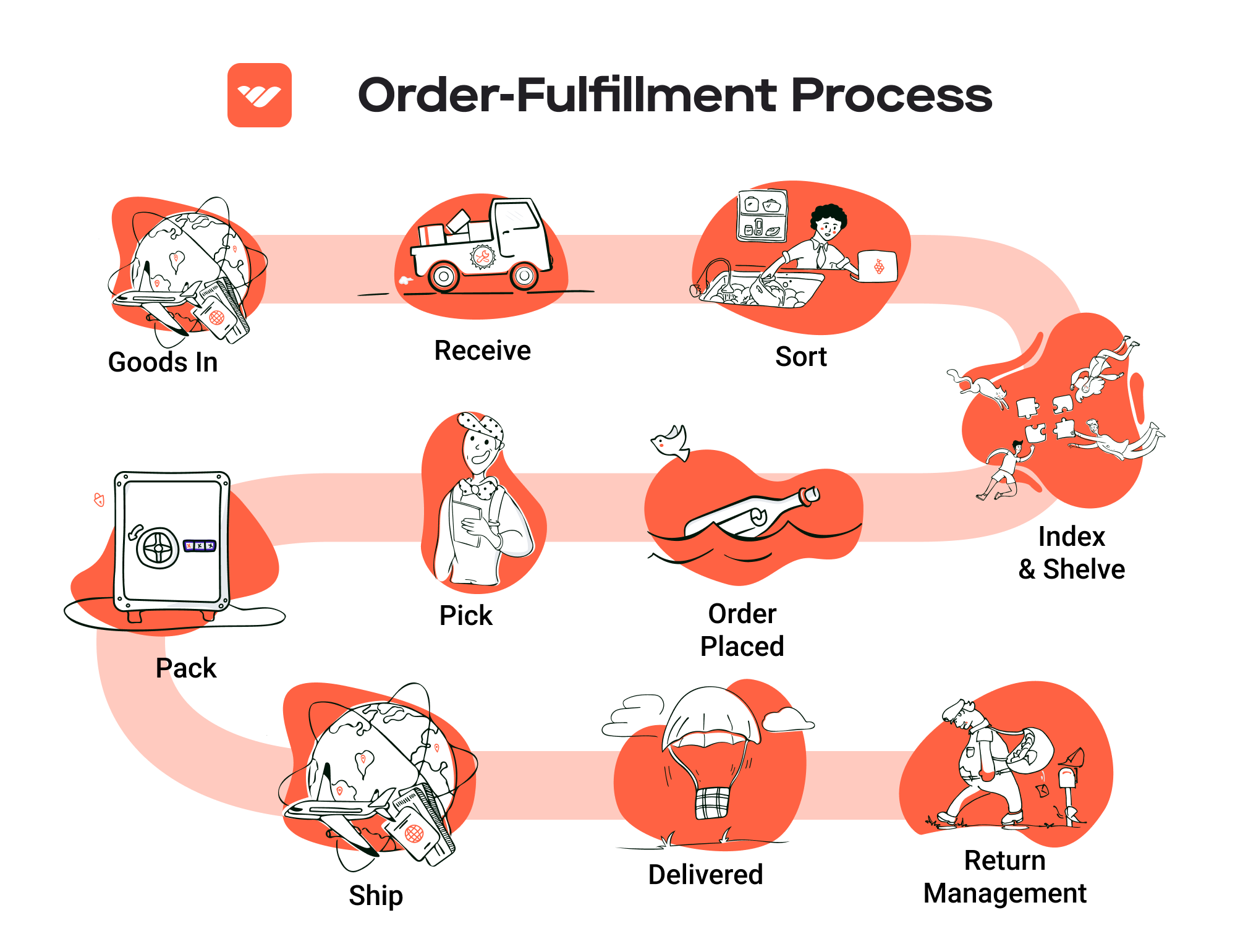
Key Term: Tracking Information – A unique code provided by the shipping carrier that allows customers to monitor the status and location of their shipment in real-time.
In conclusion, each step in the order fulfillment process is interconnected and plays a vital role in the overall efficiency of e-commerce operations. By streamlining these processes, businesses can enhance customer satisfaction, reduce operational costs, and position themselves for scalable growth in an increasingly competitive landscape.
Comparing Fulfillment Models: In-House vs. 3PL vs. Dropshipping
Fulfillment Model Comparison
| Model | Who Handles Inventory | Best For (Business Stage) | Key Advantage | Key Disadvantage |
|---|---|---|---|---|
| In-House Fulfillment | The business itself | Startups to mid-sized businesses | Total control over inventory and branding | High operational costs and labor needs |
| Third-Party Logistics (3PL) | Third-party provider | Growing businesses scaling operations | Scalability and expertise in logistics | Less control over the fulfillment process |
| Dropshipping | Supplier or manufacturer | New businesses or niche markets | Low startup costs and no inventory risk | Lower profit margins and longer shipping times |
In-House Fulfillment
In-house fulfillment refers to the process where an e-commerce business manages its own inventory, warehousing, and shipping operations. This model is especially beneficial for startups and mid-sized businesses that are looking to maintain a high level of control over their products and customer experience. By handling fulfillment internally, businesses can tailor the packaging, shipping methods, and even customer interactions, creating a more personalized experience that can enhance brand loyalty. Moreover, this model allows for real-time inventory management, enabling businesses to quickly adapt to changes in demand and streamline their operations without the need for third-party interventions.
However, in-house fulfillment comes with significant challenges. The most notable is the high operational cost associated with warehousing, staffing, and logistics. As order volumes increase, the need for more sophisticated technology and processes also rises, which can become a financial burden. Additionally, managing fulfillment requires expertise in logistics, which might not be a core competency for many businesses. This can lead to inefficiencies and increased overhead if not managed properly.
Third-Party Logistics (3PL)
Third-party logistics (3PL) providers like Verde Fulfillment specialize in managing the logistics and fulfillment processes for multiple clients. These companies handle everything from warehousing and inventory management to shipping and returns. This model is ideal for growing businesses that are looking to scale operations without the need for significant investment in infrastructure. Utilizing a 3PL allows businesses to focus on their core competencies, such as product development and marketing, while leaving the complexities of logistics to experts.
One of the key advantages of 3PL is scalability. As a business grows, a 3PL can easily adjust to increased order volumes and offer additional services such as omnichannel fulfillment and compliance solutions. Moreover, established 3PL providers have established relationships with freight carriers, often resulting in better shipping rates and faster delivery times. However, the main disadvantage is the reduced control over the fulfillment process. Businesses may experience delays or issues that are beyond their immediate control, which can impact customer satisfaction. Additionally, relying on a third party introduces potential risks related to data security and service quality.
Dropshipping
Dropshipping is a fulfillment model where the retailer does not keep products in stock but instead transfers customer orders and shipment details directly to a manufacturer or wholesaler, who then ships the products directly to the customer. This model is particularly appealing for new businesses or those operating in niche markets, as it eliminates the need for upfront inventory investment and reduces operational costs.
The primary advantage of dropshipping is the low barrier to entry. Entrepreneurs can launch their businesses with minimal capital since they do not need to purchase inventory upfront. This model also allows for a wide product selection without the risk of overstocking. However, dropshipping also has notable disadvantages, including lower profit margins due to reliance on suppliers and longer shipping times, which can lead to customer dissatisfaction. Additionally, the retailer has little control over inventory levels and product quality, which can complicate customer service and returns.
Conclusion
Choosing the right fulfillment model is crucial for the success of an e-commerce business. Each model—In-House Fulfillment, Third-Party Logistics (3PL), and Dropshipping—offers distinct advantages and disadvantages that align with different business stages and goals. Understanding these differences allows business owners to make informed decisions that best suit their operational needs and growth strategies. As you consider your options, weigh the control, cost, scalability, and customer experience each model provides to find the optimal fit for your e-commerce journey.
A Deep Dive into Amazon FBA: Pros, Cons, and Who It’s For
Understanding Fulfillment by Amazon (FBA)
Fulfillment by Amazon (FBA) is a service provided by Amazon that allows e-commerce sellers to store their products in Amazon’s fulfillment centers. Amazon then takes care of storage, packaging, shipping, and customer service on behalf of the sellers. This model enables sellers to leverage Amazon’s vast logistics network and customer base while focusing on other aspects of their business.
How FBA Works
-
Product Listing and Enrollment: Sellers start by creating an Amazon seller account and listing their products on the platform. Once the products are listed, sellers enroll in FBA.
-
Shipping Inventory: Sellers send their products to Amazon’s fulfillment centers. They must adhere to Amazon’s guidelines regarding packaging and labeling.
-
Storage: Once received, Amazon stores the products in their warehouses. Sellers can track their inventory levels through the Seller Central dashboard.
-
Order Fulfillment: When a customer places an order for a product, Amazon picks, packs, and ships the item directly to the customer. They handle all aspects of logistics, including shipping and returns.
-
Customer Service: Amazon also manages customer service inquiries and returns for FBA orders, providing a seamless experience for both the seller and the customer.
-
Payment: After the sale, Amazon deducts fees associated with FBA (more on this later) and deposits the remaining amount into the seller’s account.
Pros of Using Amazon FBA
-
Prime Eligibility: One of the most significant advantages of FBA is that products become eligible for Amazon Prime, which attracts millions of Prime subscribers who prefer faster shipping options. This can lead to increased sales and better visibility in search results.
-
Customer Trust: By using FBA, sellers benefit from Amazon’s established reputation. Customers are more likely to purchase products fulfilled by Amazon due to the trust associated with the brand, knowing they will receive reliable service and support.
-
Multi-Channel Fulfillment: FBA allows sellers to fulfill orders not only from Amazon but also from other sales channels such as their own e-commerce websites. This flexibility means sellers can centralize their inventory management and logistics through Amazon.
-
Scalability: FBA is particularly beneficial for businesses looking to scale quickly. As order volumes increase, Amazon’s infrastructure can handle the growth without requiring sellers to invest heavily in their own logistics.
-
Time Savings: Outsourcing fulfillment to Amazon frees up valuable time for sellers. Instead of managing logistics, they can focus on product development, marketing, and customer engagement.
Cons of Using Amazon FBA
-
High Fees: While FBA provides numerous advantages, it comes with significant costs. Sellers must pay storage fees based on the amount of inventory stored and fulfillment fees for each item sold. These costs can eat into profit margins, especially for low-priced items.
-
Strict Inventory Rules: Amazon has stringent guidelines regarding inventory management. Sellers must comply with requirements related to product preparation, packaging, and labeling. Non-compliance can result in additional fees or even inventory removal.
-
Commingling Risks: FBA operates on a commingled inventory model, meaning that products from multiple sellers may be stored together. This can pose risks, such as receiving returns of items that do not belong to the seller, which can complicate inventory management and customer service.
-
Less Control Over Fulfillment: When utilizing FBA, sellers relinquish control over the fulfillment process. This can lead to issues with packaging, shipping speed, and customer service, which may not align with the seller’s brand standards.
-
Dependency on Amazon: Relying heavily on FBA can make sellers vulnerable to changes in Amazon’s policies or fee structures. Any alterations in these areas can significantly impact a seller’s bottom line and overall business strategy.
Who is FBA Best For?
Fulfillment by Amazon is particularly well-suited for:
-
Small to Medium-Sized Businesses: Companies looking to scale quickly without investing in their own logistics infrastructure can benefit immensely from FBA. It allows them to focus on growth while Amazon manages fulfillment.
-
Sellers with High-Volume Products: Businesses that sell fast-moving consumer goods (FMCG) or products with high sales velocity can take advantage of FBA’s logistics capabilities and maximize their profit potential.
-
New Entrants to E-commerce: Startups and entrepreneurs entering the e-commerce space can leverage FBA to get their products to market quickly and efficiently without needing extensive knowledge of logistics.
-
Brands Seeking Prime Access: Sellers looking to reach Amazon’s vast Prime customer base will find FBA indispensable, as it enhances product visibility and can lead to increased sales.
In conclusion, while Amazon FBA offers numerous benefits, it is essential for sellers to carefully evaluate their business model, product types, and long-term goals before committing to this fulfillment strategy. By understanding both the advantages and drawbacks, e-commerce businesses can make informed decisions that align with their growth objectives.
Core Services Offered by Fulfillment Centers
Inventory Management & Warehousing
Effective inventory management and warehousing form the backbone of a successful e-commerce operation. Fulfillment centers utilize advanced technology and optimized processes to ensure that inventory levels are accurately monitored and maintained. This service includes real-time tracking of stock levels, automated reordering alerts, and comprehensive reporting capabilities.
The benefit of this service for e-commerce businesses is multifaceted. Firstly, it minimizes the risk of stockouts or overstocking, which can lead to lost sales or increased carrying costs, respectively. By leveraging sophisticated inventory management systems, businesses can forecast demand more accurately, enabling them to make informed decisions about inventory purchases. Additionally, strategically located warehouses allow for reduced shipping times and costs, enhancing customer satisfaction through faster delivery.
Pick and Pack Services
Pick and pack services are a critical component of the fulfillment process, involving the selection of items from inventory and preparing them for shipment. Fulfillment centers employ streamlined workflows and automation to efficiently pick items based on customer orders, followed by packing them securely for transport. This process can vary from simple single-item orders to complex multi-item bundles.
For e-commerce businesses, the primary advantage of pick and pack services is the speed and accuracy they bring to order fulfillment. Quick turnaround times can significantly improve customer satisfaction and retention, as buyers increasingly expect swift deliveries. Moreover, fulfillment centers utilize quality control measures to ensure that the right products are picked and packed correctly, thereby reducing returns due to shipping errors. This not only enhances the brand’s reputation but also lowers operational costs associated with handling returns.
Kitting and Assembly
Kitting and assembly refer to the process of grouping multiple products into a single package or assembling components into a finished product before shipping. This service is particularly beneficial for businesses that offer product bundles, promotional items, or customized orders. Fulfillment centers can handle everything from assembling gift sets to creating complex product configurations that require multiple components.
The primary benefit of kitting and assembly is the added value it provides to the customer. By offering bundled products or customized assemblies, e-commerce businesses can enhance their product offerings and differentiate themselves in a competitive market. This service can also streamline the fulfillment process, as orders are packaged in bulk rather than individually, reducing labor costs and speeding up the shipping process. Additionally, it allows businesses to optimize inventory management by consolidating various components into a single SKU, simplifying stock tracking and replenishment.
Returns Management (Reverse Logistics)
Returns management, or reverse logistics, is an essential service offered by fulfillment centers that handles the process of returns from customers back to the warehouse. This includes receiving returned items, inspecting them for quality, restocking them, and processing refunds or exchanges. Effective returns management is crucial for maintaining customer satisfaction and loyalty.
The benefit of having a robust returns management system in place is significant for e-commerce businesses. A streamlined process not only enhances the customer experience by making returns easy and hassle-free, but it also provides valuable insights into product performance and customer preferences. By analyzing return data, businesses can identify common issues, such as defective products or sizing problems, allowing them to make informed decisions about product development and inventory management. Moreover, efficient returns processing can reduce costs associated with handling returns and improve cash flow, ultimately contributing to a healthier bottom line.
Conclusion
In the fast-paced world of e-commerce, partnering with a fulfillment center that offers comprehensive services such as inventory management, pick and pack, kitting and assembly, and returns management can provide a significant competitive advantage. By leveraging these core services, e-commerce businesses can enhance operational efficiency, improve customer satisfaction, and ultimately scale their operations effectively. As the industry continues to evolve, investing in a reliable fulfillment partner becomes increasingly essential for sustained growth and success.
How to Choose a Fulfillment Partner: A 6-Point Checklist
Location & Warehouse Network
The geographical location of your fulfillment partner’s warehouses plays a crucial role in determining shipping times and costs. A partner with strategically placed facilities can reduce transit times and improve customer satisfaction.
Questions to Ask:
– Where are your warehouses located, and how do these locations align with our target markets?
– Do you have a bi-coastal or multi-regional strategy to ensure efficient coverage across the country?
– How do you manage inventory distribution across your facilities to ensure optimal shipping times?
Technology & Integrations
In today’s e-commerce environment, technology is a game-changer. A robust fulfillment partner should offer a sophisticated technology stack that supports seamless integrations with your existing systems—be it shopping carts, ERP, or EDI systems.
Questions to Ask:
– What technology do you use for order management and inventory tracking?
– Can your system integrate with our current e-commerce platforms and software?
– Do you provide real-time tracking and reporting capabilities for orders and inventory?
Specializations (e.g., Cold Storage, Oversized Items)
Depending on your product offerings, certain fulfillment partners may have specific capabilities that align better with your needs. For example, if you sell perishable goods, a partner with cold storage facilities is essential. Similarly, oversized or bulky items may require specialized handling.
Questions to Ask:
– What types of products do you specialize in handling?
– Do you have the necessary equipment and facilities to manage our specific product requirements?
– Can you provide examples of how you’ve successfully handled similar products for other clients?
Scalability & Capacity
As your business grows, your fulfillment partner should be able to scale operations accordingly. It’s vital to choose a provider that can handle increased order volumes without compromising on service quality.
Questions to Ask:
– What is your current capacity, and how do you plan to manage growth in the future?
– How do you handle peak seasons or unexpected surges in demand?
– Can you provide case studies or references from clients who have successfully scaled with your services?
Pricing and Contracts
Understanding the pricing structure and contract terms is crucial for long-term financial planning. A transparent pricing model helps you avoid unexpected costs and ensures that your budget aligns with your fulfillment operations.
Questions to Ask:
– What is your pricing model (e.g., per order, per item, monthly fees)?
– Are there any additional fees for services like storage, returns, or special handling?
– What are the terms of the contract, and is there flexibility to adjust as our needs change?
Customer Support & Reviews
Effective customer support is essential for addressing any issues that arise during the fulfillment process. Additionally, researching customer reviews can provide insights into the partner’s reliability and quality of service.
Questions to Ask:
– What kind of customer support do you offer (e.g., dedicated account manager, 24/7 support)?
– Can you provide references or testimonials from current clients?
– How do you handle problem resolution, and what is your average response time for inquiries or issues?
Conclusion
Choosing the right fulfillment partner is a critical decision that can significantly impact your e-commerce business’s efficiency and customer satisfaction. By following this checklist and asking the right questions, you can make an informed choice that aligns with your operational needs and growth aspirations. Remember, the goal is to find a partner that not only meets your current requirements but can also adapt and grow with your business over time.
Understanding Fulfillment Pricing: A Breakdown of Common Fees
Initial Setup Fees
When partnering with a third-party logistics (3PL) provider, businesses often encounter initial setup fees. These charges cover the cost of integrating your systems with the 3PL’s technology and establishing your account. Setup fees can vary widely based on the complexity of your operations and the level of customization required. For instance, if your business utilizes multiple sales channels or has specific compliance needs, the setup process may require more time and resources, leading to higher fees. Typically, these fees can range from a few hundred to several thousand dollars, depending on the provider and the services needed.
Receiving Fees
Receiving fees are incurred when your inventory arrives at the fulfillment center. This fee compensates the 3PL for unloading, inspecting, and entering your products into their inventory management system. Charges are often calculated based on the volume of goods received, usually measured in pallets or individual items. Some providers may also charge additional fees for special handling, such as inspecting for damages or sorting items. Understanding how these fees are structured is crucial, as they can significantly impact your overall fulfillment costs, especially during peak seasons when inventory turnover is high.
Storage Fees (per pallet/bin)
Storage fees are charged for keeping your inventory in the 3PL’s warehouse. These fees can be calculated on a per-pallet or per-bin basis, depending on the provider’s pricing model. Typically, storage fees are billed monthly and can vary based on the size of the pallet or the specific storage requirements of your items. For example, if your products require climate-controlled storage, you may face higher fees compared to standard storage. Additionally, some providers offer tiered pricing, where the cost per pallet decreases as you store more pallets. Understanding your inventory turnover rate is essential for estimating these fees accurately.
Pick & Pack Fees (per item/order)
Pick and pack fees are charged for the labor involved in retrieving items from storage and preparing them for shipment. This fee can be based on several factors, including the number of items in an order, the complexity of the packing process, and any special packaging requirements. For instance, a basic pick and pack operation might charge a flat fee per order, while more complex orders requiring custom packaging or multiple items could incur higher fees. It’s important to clarify how these fees are structured with your 3PL partner, as they can vary significantly between providers and can impact your overall shipping costs.
Shipping Fees
Shipping fees are one of the most variable costs associated with fulfillment and can depend on various factors such as the shipping method, destination, package weight, and dimensions. Most 3PLs negotiate rates with carriers, which can lead to cost savings for your business. Shipping fees can be structured as flat rates, weight-based, or distance-based, and may also include surcharges for expedited shipping or handling of oversized items. Understanding how shipping fees are calculated is vital for budgeting and pricing your products accurately.
Tips for Obtaining an Accurate Quote
-
Be Transparent About Your Needs: When seeking quotes from 3PL providers, clearly outline your business model, expected order volume, and any specific requirements. This information will help them provide a more accurate estimate.
-
Request Detailed Pricing Structures: Ask for a breakdown of all potential fees, including any variable costs that may arise based on order fluctuations or seasonal demands.
-
Compare Multiple Providers: Don’t settle for the first quote you receive. Comparing multiple 3PLs can reveal significant differences in pricing and service offerings, allowing you to make an informed decision.
-
Consider Long-Term Contracts: Some providers may offer discounts for long-term commitments. If you anticipate growth, negotiating a longer-term contract could save you money in the long run.
-
Evaluate Additional Services: Consider any additional services provided by the 3PL, such as inventory management software or customer support, which could add value to your partnership and justify the costs.
By understanding these common fulfillment pricing models and following these tips, you can make informed decisions that align with your business goals and budget.
Frequently Asked Questions (FAQs) about Fulfillment
1. What is Verde Fulfillment?
Verde Fulfillment is a leading third-party logistics (3PL) provider specializing in omnichannel fulfillment solutions for e-commerce businesses. With 11 strategically located facilities across the U.S., Verde leverages advanced technology to streamline order processing, inventory management, and shipping for both direct-to-consumer (DTC) and business-to-business (B2B) operations.
2. What is a 3PL?
A third-party logistics (3PL) provider is a company that offers outsourced logistics services, including warehousing, transportation, and order fulfillment. Businesses partner with 3PLs to enhance operational efficiency, reduce costs, and scale their logistics capabilities without the need for substantial capital investment in infrastructure.
3. How does Verde Fulfillment optimize inventory management?
Verde Fulfillment employs a proprietary technology stack that includes real-time inventory tracking and advanced optimization logic. This ensures that inventory is positioned in the right locations to meet demand quickly and efficiently, enabling businesses to manage their stock levels effectively across various sales channels.
4. How much do fulfillment services cost?
The cost of fulfillment services can vary widely based on factors such as order volume, storage space required, and specific services offered (e.g., picking, packing, shipping). Verde Fulfillment provides customized pricing based on the unique needs of each client, ensuring transparency and scalability as businesses grow.
5. What’s the difference between a warehouse and a fulfillment center?
While both warehouses and fulfillment centers store products, their primary functions differ. A warehouse is mainly for storage, focusing on holding inventory over longer periods. In contrast, a fulfillment center is designed for rapid order processing and shipping, emphasizing efficiency in getting products from the warehouse to the customer’s doorstep quickly.
6. How does Verde Fulfillment handle returns management?
Verde Fulfillment offers comprehensive returns management solutions that streamline the process for both businesses and customers. This includes efficient processing of return shipments, updating inventory in real-time, and providing detailed reporting to help businesses analyze return trends and improve product offerings.
7. What types of businesses can benefit from Verde Fulfillment?
Verde Fulfillment caters to a wide range of businesses, from small startups to established brands, across various industries. Companies looking to enhance their DTC and B2B sales channels, optimize logistics, or scale their fulfillment operations can benefit significantly from Verde’s services.
8. What integrations does Verde Fulfillment support?
Verde Fulfillment supports over 150 integrations with various shopping carts, ERP systems, and EDI compliance software. This allows businesses to connect their existing systems seamlessly, ensuring efficient order processing and accurate inventory management across multiple sales channels.
9. How does Verde Fulfillment ensure timely delivery?
Verde’s bi-coastal strategy positions fulfillment centers in key locations across the U.S., optimizing shipping routes and reducing delivery times. The company also partners with top-tier freight carriers to ensure reliable transportation services, allowing for quick and efficient order fulfillment.
10. How can businesses get started with Verde Fulfillment?
Businesses interested in partnering with Verde Fulfillment can begin by reaching out through their website for a consultation. During this process, Verde’s team will assess specific needs, discuss potential solutions, and create a tailored fulfillment strategy to support the business’s growth and operational efficiency.
Conclusion: Is Outsourcing Fulfillment the Right Move for Your Business?
Evaluating the Benefits of Outsourcing Fulfillment
Outsourcing your fulfillment can be a transformative decision for your e-commerce business, offering several key benefits that can enhance your operational efficiency and bottom line. First and foremost, partnering with a professional fulfillment service saves you significant time. Instead of managing logistics, inventory, and shipping processes in-house, you can focus on what truly drives your business—growth, marketing, and customer engagement.
Scalability is another crucial advantage. As your sales volume increases, a reliable fulfillment partner can easily adapt to your needs, ensuring that your operations can expand without the need for substantial upfront investment in warehousing or additional staff. This flexibility allows you to scale up during peak seasons or scale down when demand fluctuates, providing a cushion against market volatility.
Furthermore, leveraging the expertise of a specialized fulfillment service means that you benefit from advanced technologies and logistics strategies that may be beyond your current capabilities. A reputable partner, like Verde Fulfillment, not only streamlines order processing but also enhances inventory management and integrates seamlessly with various sales platforms. Their experience in navigating complexities such as compliance and international shipping can significantly reduce your operational risks.
However, it’s essential to choose the right fulfillment partner to ensure your growth strategy aligns with their capabilities. Look for a provider that offers comprehensive services tailored to your business model and can scale as you grow.
Take Action
To determine if outsourcing fulfillment is the right move for your business, conduct an audit of your current shipping processes. Assess your operational efficiency, costs, and customer satisfaction levels. This analysis will provide clarity on whether a fulfillment partner could enhance your logistics strategy and support your business’s growth ambitions. Don’t hesitate to reach out to potential partners to discuss your specific needs and explore how they can help you achieve your goals.
Important Disclaimer
⚠️ Important Disclaimer
The information in this guide is for educational purposes. Fulfillment services, pricing, and platform features change frequently. Always conduct your own due diligence and consult with providers directly before making business decisions.
